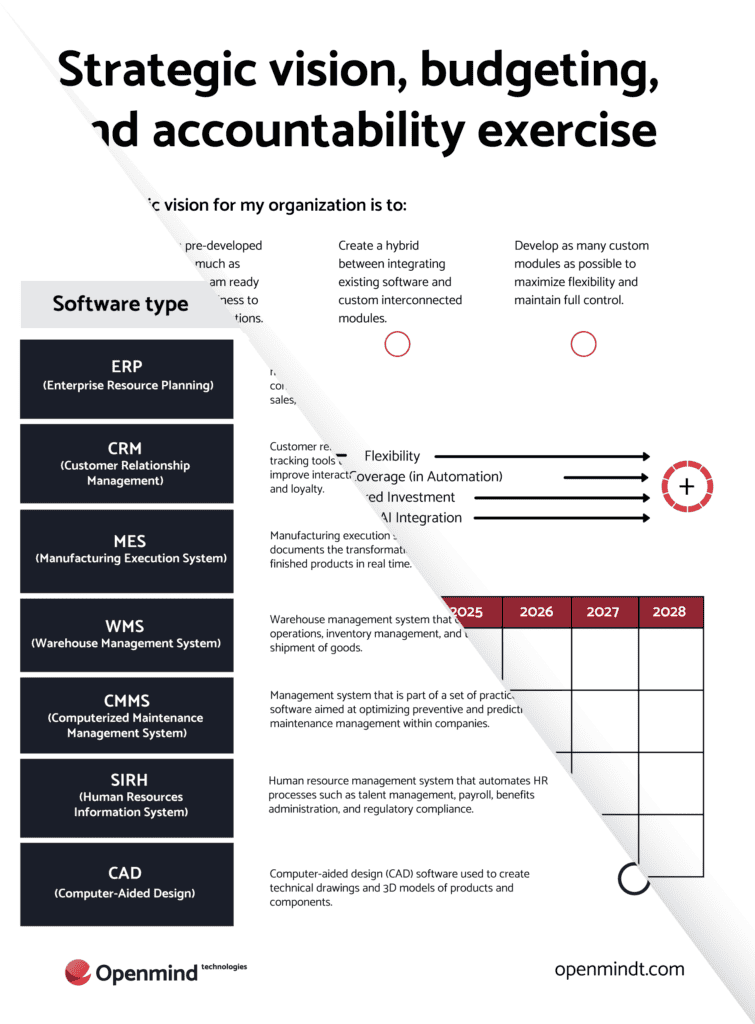Elevate your manufacturing strategy with key resources
Download our Technological Maturity Self-Assessment & Strategic Vision Exercise tools to assess your software ecosystem profile and to plan for future growth.

For a snapshot of the overall performance of your internal processes, dashboards will help you evaluate your company’s operations at any time. A good dashboard will give you a detailed look at your company in one glance.
Clearly, not just any dashboard will meet your specific needs. And since these dashboards can take your company to a whole new level, it is essential to choose the right ones to support your company’s growth. We will introduce you to the different types of dashboards that can substantially improve your efficiency.
The greatest strength of a dashboard is that it is highly customizable, which will allow you to keep track of almost all measurable aspects of your company. However, that can be a drawback, because it can be tempting to add information that is less relevant, or that does not really meet your needs.
Choosing a good dashboard depends first on your general objectives. A good dashboard should enable you to meet the objectives you set for yourself by presenting relevant information. Choosing the wrong dashboards could be catastrophic for your company by causing you to overlook important information, or worse: leading you to error with inadequate information.
First, you will need to understand the different types of dashboards in order to pick the best one for your goals, and then define the right key performance indicators (KPIs). Keep in mind that you will very likely use the information presented in these boards to make strategic decisions for your company.
For a manufacturing company, dashboards will be used mainly to track key KPIs in order to evaluate the performance of the various operational processes in place. A dashboard will need to present different indicators to monitor and optimize production quality. Similarly, you can use a dashboard to have a view on the supply chain in order to identify the parts that are working well and those that need to be improved.
Having good visibility on your key performance indicators (KPI) allows you to make informed decisions to improve production processes, reduce costs and satisfy customers. In addition, a good understanding of these indicators can help you anticipate market trends and develop strategies to maintain and increase your company’s competitiveness.

Download our Technological Maturity Self-Assessment & Strategic Vision Exercise tools to assess your software ecosystem profile and to plan for future growth.

You have the choice between three different types of dashboard, depending on your objectives. What makes them different are the KPIs available in your dashboards: Financial KPIs, activity KPIs, profitability KPIs, etc.

Definition: A dashboard with concise information on KPIs relating to the company’s overall health.
Objective: This type of dashboard is designed for executives to get an overall picture of the company’s operations. The strategic dashboard is therefore most useful for directors who need a quick inventory overview of the company’s important aspects. This way, they can track performance indicators in relation to the company’s strategic objectives.
It provides an overview of KPIs linked to the company’s strategic objectives, rather than a detailed report on each aspect of the company. It is primarily used for daily consultation, to keep viewers up to date on the company’s overall performance.

Definition: Also known as a management or budget dashboard, this type of dashboard is used to monitor the company’s financial condition.
Objective: The main objective of this type of dashboard is to control the company’s management performance level. It is used to evaluate financial performance and compare it to forecasts and previously determined objectives. With this kind of dashboard, you can identify the differences between your projections (your objectives) and reality. In the same way, it highlights past data to identify trends and forecast results to set future objectives.
The budget dashboard generally contains KPIs such as sales volumes, order backlog, revenue, etc. Unlike strategic dashboards, budget dashboards are viewed less often and are primarily used for weekly or monthly meetings.

Definition: Also known as an operational dashboard, this is the perfect tool for tracking and evaluating the performance of operational processes within your company.
Objective: As a tool that tracks a company’s operational performance, this type of dashboard is used to track progress toward the company’s operational objectives. In addition to tracking, this tool identifies internal processes that are working optimally, and those that still require improvement.
Generally speaking, operational dashboards present data in real time, looking at the purely operational performance status of your company. For this reason, they are viewed relatively often with a short-term perspective, unlike strategic and budget dashboards, which are more focused on the long-term.
Of course, the best option is to have all 3 different types of dashboards to help you steer your company. From this perspective, it is essential to understand that creating your own dashboard is not something to take lightly. It takes some forethought, and you must keep your objectives and needs in mind.
The most important thing is to take the time to develop and design your dashboards to get the most of them, turning them into high-performance tools that enable your company to rise above the competition.
For more insights on the benefits of using dashboards in manufacturing, check out our article on the 8 Advantages of Having a Dashboard for a Manufacturing Company.
Subscribe to receive our exclusive updates directly to your email.
